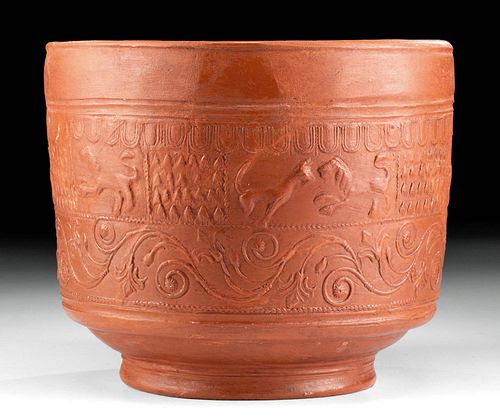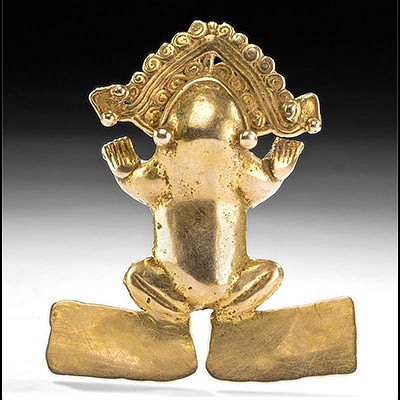Roman Terra Sigillata Arretine Molded Pottery Bowl
Lot 33a
About Seller
Artemis Fine Arts
686 S Taylor Ave, Ste 106
Louisville, CO 80027
United States
Selling antiquities, ancient and ethnographic art online since 1993, Artemis Gallery specializes in Classical Antiquities (Egyptian, Greek, Roman, Near Eastern), Asian, Pre-Columbian, African / Tribal / Oceanographic art. Our extensive inventory includes pottery, stone, metal, wood, glass and textil...Read more
Categories
Estimate:
$2,500 - $3,500
Absentee vs Live bid
Two ways to bid:
- Leave a max absentee bid and the platform will bid on your behalf up to your maximum bid during the live auction.
- Bid live during the auction and your bids will be submitted real-time to the auctioneer.
Bid Increments
| Price | Bid Increment |
|---|---|
| $0 | $25 |
| $300 | $50 |
| $1,000 | $100 |
| $2,000 | $250 |
| $5,000 | $500 |
| $10,000 | $1,000 |
| $20,000 | $2,500 |
| $50,000 | $5,000 |
| $100,000 | $10,000 |
| $200,000 | $20,000 |
About Auction
By Artemis Fine Arts
Aug 13, 2020
Set Reminder
2020-08-13 10:00:00
2020-08-13 10:00:00
America/New_York
Bidsquare
Bidsquare : Fine Antiquities, Ethnographic & Fine Art
https://www.bidsquare.com/auctions/artemis-gallery/fine-antiquities-ethnographic-fine-art-5415
Features classical antiquities, ancient and ethnographic art from cultures encompassing the globe. Egyptian, Greek, Roman, Etruscan, Near Eastern, Asian, Pre-Columbian, Native American, African / Tribal, Oceanic, Spanish Colonial, Russian, Fine Art, so much more! Artemis Fine Arts info@artemisfinearts.com
Features classical antiquities, ancient and ethnographic art from cultures encompassing the globe. Egyptian, Greek, Roman, Etruscan, Near Eastern, Asian, Pre-Columbian, Native American, African / Tribal, Oceanic, Spanish Colonial, Russian, Fine Art, so much more! Artemis Fine Arts info@artemisfinearts.com
- Lot Description
Roman, Imperial Period, ca. late 1st century BCE to early 1st CE. Created in a mold, a charming terra sigilata vessel with a characteristically rich red finish and an impressive iconographic/decorative program adorning the exterior walls. From the top: a band of stylized tongues; a register of confronting zoomorphs - one horned the other leonine - alternating with panels of repeated triangular motifs perhaps to represent animal pelt or teeth - separated by rope borders; and a register of scrolling floral vines. The cylindrical bowl sits upon a tiered base with a circular concave foot. Terra Sigilata refers to the method used to seal the red slip onto the pottery during the firing process. The vessel was mold made and would have been traded throughout the Roman Empire. The technique used to finish the slip on pieces like this one led to its name, terra sigilata, literally meaning "sealed earth" - how poetic! Size: 6.25" W x 5.25" H (15.9 cm x 13.3 cm)
Terra sigillata is a fine type of Roman ceramic coveted for its smooth red slipped finish and intriguing relief decoration. According to the Walters Museum, "The vessel and decorations were formed in a mold and were sometimes embellished with stamps, roller-dies, appliqués, barbotine, and incision. This type of pottery emerged around 40 BCE in Arretium (modern Arezzo) in central Italy and had an enormous influence across the Empire. In Gaul (modern France), cities like Lezoux, Montans, and the ancient site of La Graufesenque developed into prolific centers of terra sigillata wares."
Provenance: private Orange County, California, USA collection acquired before 2000
All items legal to buy/sell under U.S. Statute covering cultural patrimony Code 2600, CHAPTER 14, and are guaranteed to be as described or your money back.
A Certificate of Authenticity will accompany all winning bids.
We ship worldwide and handle all shipping in-house for your convenience.
#157401Repaired from numerous pieces with about 25% restoration. Surviving details still quite vivid and vessels of this variety are so rare and desirable that we still find it an exceptional example.Condition
- Shipping Info
-
All shipping is handled in-house for your convenience. Your invoice from Artemis Gallery will include shipping calculation instructions. If in doubt, please inquire BEFORE bidding for estimated shipping costs for individual items.
-
- Buyer's Premium



 EUR
EUR CAD
CAD AUD
AUD GBP
GBP MXN
MXN HKD
HKD CNY
CNY MYR
MYR SEK
SEK SGD
SGD CHF
CHF THB
THB
















